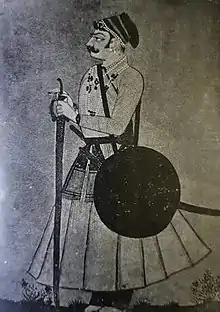Ratan Singh Rathore
Ratan Singh was the founder of Ratlam, governor of 16 parganas in northern Malwa and a renowned warrior of his time. He gained fame under the patronage of the Mughal emperor Shah Jahan.[1]
| Maharaja Ratan Singh | |
|---|---|
 Depiction of Ratan Singh Rathore | |
| Reign | 1648-1658 |
| Predecessor | Maheshdas Rathore of Jalore |
| Successor | Ram singh |
| Born | 1618 Jalore, Rajasthan |
| Died | 15 April 1658 Dharmatpur, near Ujjain |
| Spouse | Sukhroopede Kanwar Shekhawat |
| Issue | Ram Singh Rai Singh Nahar Singh Chattrasal Akheraj Sakat Singh |
| House | Rathore |
| Father | Maheshdas Rathore |
Life
Ratan Singh was from a younger branch of the Rathore ruling family in Jodhpur. At a young age of twenty-three, Ratan Singh, armed with nothing but a dagger fought and killed a mad elephant in the streets of Delhi and impressed its Emperor.[1] Ratan Singh was recruited as an imperial general by Shah Jahan and was posted in Afghanistan as a mansabdar. He continued to gain fame by defeating wild bands of central Asian invaders and by later campaigning against the Persians under the Mughal prince Dara Shukoh. In 1648 he was given a Mughal rank of 3000 horsemen, the standard of Mahi Maratib and the Jagir of Malwa, where he made Ratlam his capital.[1] Ratan Singh was soon informed about Aurangzeb and Murad's betrayal and he immediately came to the aid of Shah Jahan to stop the Mughal princes. Ratan Singh fought the rebel army at Dharmatpur on 15 April 1658, most sources say that the Mughal generals deputed by Shah Jahan either fled or remained inactive throughout the battle. Ratan Singh thus took command of the remaining army and fought till his death.[2][3] [4][5][6]
Recognition
According to the Karuna Joshi - "The Battle of Dharmat did not end after Jaswant Singh's flight from the war, but it was finished after the death of Ratan Singh." "Though Jaswant Singh fought bravely and got wounded, his escape from the battlefield was considered to be derogatory according to the custom of Rajasthan. So he obtained no place in the heroic poetry of Rajasthan. But Ratan singh's bravery, courage and sacrifice brought him name and fame which was amply described in the poems of contemporary poets like Khadia Jaga and Kumbhakaran Sada."[7]
James Tod has written - "Of all the deeds of heroism performed on this day, those of Ratan of Ratlam by universal consent are pre-eminent and are wreathed into immortal rhyme by the bard in the Rasa Rao Ratna."[5]
"Banhe Raso" , "Ratan Raso" and "Vachanika Rathore Ratan Maheshdasot Ri" are some works of Rajasthani literature that have written about Ratan Singhs life.[8]
According to Norbert Peabody: The Ratan Raso explains the gory events of Dharmat in a very detailed manner, however it ignores the various victories enjoyed by Ratan Singh in his military career.[9]
Successors
His successors founded the states of Ratlam, Sailana, Sitamau,[1] Kachhi-Baroda and Multhan . Several estates and Thakurate's also claim descent from Ratan singh.
See also
References
- Ramusack, Barbara N. (8 January 2004). The Indian Princes and their States. Cambridge University Press. p. 16. ISBN 9781139449083. Retrieved 2020-09-14.
- Madhya Pradesh: Ratlam, Pg41, government central press 1994. —"Kasim Khan remained inactive throughout the battle and Jaswant Singh, before leaving for Marwar, handed over the command of the army to Ratan Singh Rathor."
- history of modern India from 1526 A.D. to the present day. 3d ed. V. N. Hari Rao, Rochouse, 1969 - India, pg61. - "while Kasim Khan remained inactive throughout the battle."
- Encyclopaedia of Indian Literature:Sasay to Zorgot. Sahitya Akademi. 1992. p. 4456. ISBN 9788126012213. Retrieved 2020-09-15.
- J. W. Bond, R. V. Solomon (2006). Indian States: A Biographical, Historical, and Administrative Survey. p. 492. ISBN 9788120619654. Retrieved 2020-09-13.
- Krishnan, V.S. (1994). Pradesh District Gazetteers: Ratlam. Government Central Press. p. 37. Retrieved 2020-09-15.
- Joshi, Karuna (1998). "New Light on the Battle of Dharmat". Proceedings of the Indian History Congress. Indian History Congress. 59: 427–433. JSTOR 44147010.
- Proceedings of the Indian History Congress Volume 59. Indian History Congress. 1999. pp. 427–428. Retrieved 2020-09-15.
- Peabody, Norbert (2003). Hindu Kingship and Polity in Precolonial India. Cambridge University Press. p. 91. ISBN 9780521465489. Retrieved 2020-09-14.